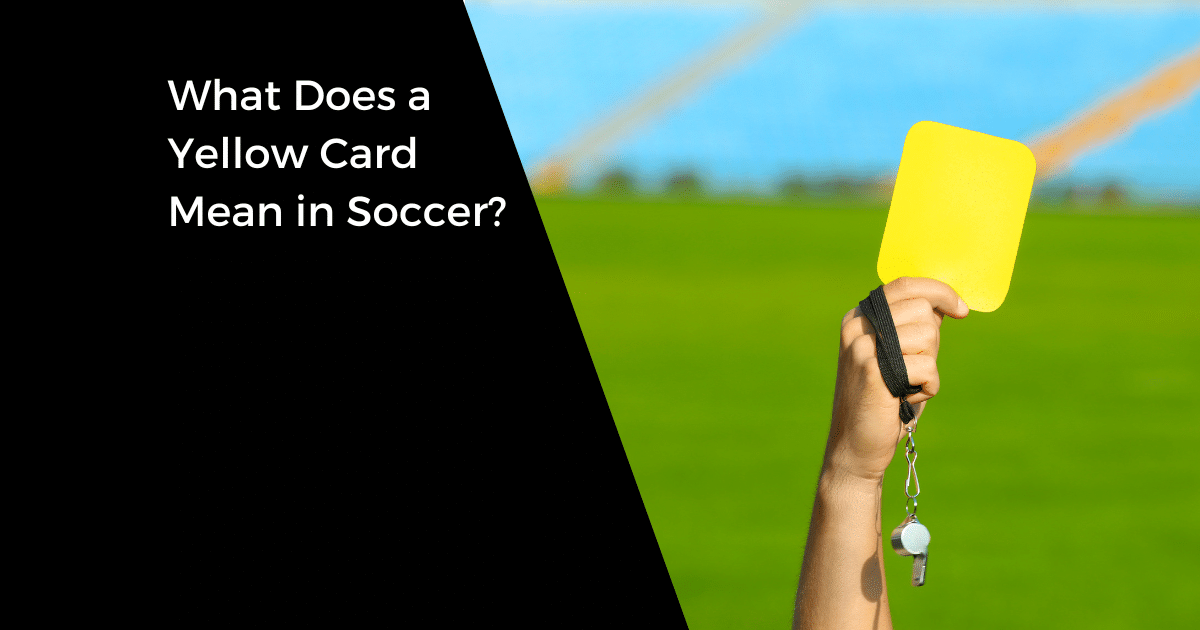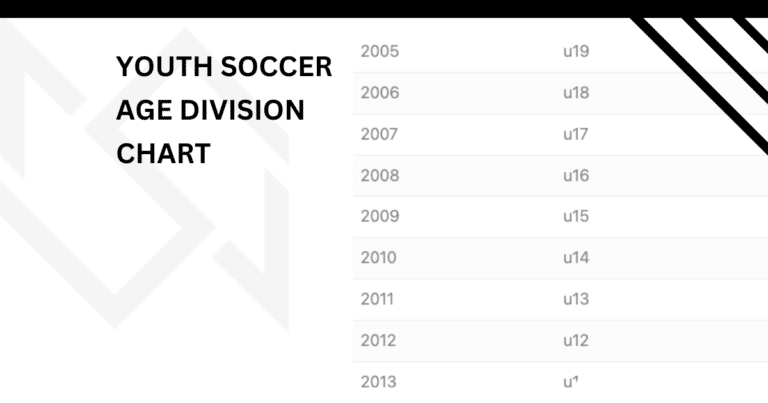What Does a Yellow Card Mean in Soccer? A Clear Explanation

A yellow card is given to a player as a warning or caution by the referee. This can be for offenses such as unsportsmanlike behavior or time-wasting.
In a soccer match, a yellow card is just part of the game. In fact, according to Footy Stats, there has been an average of 4.5 yellow cards per MLS game.
Key Takeaways From This Article:
- A yellow card is given to a player or coach as a warning for their conduct.
- Two yellow cards in a game equals a red card which means the player will be sent off the field and the team will have to play with one less player.
- Yellow cards are a necessary aspect of the game so the match doesn’t get out of control.
In youth soccer, receiving a yellow card can be catastrophic for a player. At younger ages, tantrums and tears can follow.
For players 14 years and older, yellow cards seem to become a regular occurrence.
My son’s MLS NEXT team has (4) players with two yellow cards and (2) players with three yellow cards on the season. It’s only been eight games in!
This tells me that they are playing aggressively which is great. At the same time, may need to tone down the extra pushing and shoving.
In this article, I’ll address the definition of a yellow card, suspensions, and everything else!
What is the Meaning of a Yellow Card?
The yellow card is a warning to the player that they should change their behavior, or they may be shown a red card.
A player may receive a yellow card for a variety of reasons, including:
- Committing a reckless or dangerous tackle
- Deliberately touching the ball with their hands
- Failing to respect the required distance when on a free kick
- Engaging in unsporting behavior, such as taunting, diving, or flopping
- Time-wasting or delaying the restart of play
If a player receives two yellow cards in the same game, they will be shown a red card and must leave the field.
The referee has the final say on whether a yellow card is given, and their decision is not open to appeal.
It’s important to respect the referee’s decision. Move on from the situation and continue playing your game.
What Are the Consequences of Getting a Yellow Card?

If you receive a yellow card during a soccer match, there are immediate consequences that you need to be aware of. Here they are…
Yellow Card During the Soccer Match
When you receive a yellow card during a match, the referee will record your name and the time of the offense on a card.
You can remain on the soccer field after you receive a yellow card.
But, sometimes your coach may take you off since you’re a liability of receiving a red card if another yellow card is shown to you.
This will mean that your team will be playing with one less player which can put your team at a disadvantage.
Season Consequences
Receiving a yellow card can also have consequences beyond the current match.
If you accumulate too many yellow cards during a season, you may be suspended from a future game. This varies by league.
For example, in MLS NEXT, a player who gets five yellow cards will receive a one-game suspension.
Can You Get Suspended For a Yellow Card?

“Yellow card accumulation” is used by soccer organizations to encourage players to play fair.
Depending on the rules of the league, the accumulation of yellow cards can lead to suspension.
For example, in the 2022 FIFA World Cup in Qatar, a player would receive a one-match suspension if they received two yellow cards in two different games.
If a player received five yellow cards throughout the tournament, they would get a two-match suspension.
Each youth league will most likely have its yellow card accumulation standard. Here are the current MLS NEXT and ECNL rules:
What Are the Yellow Card Rules in Soccer Leagues?
Yellow cards are a common sight in soccer matches. Their meaning is universal across different leagues…caution!
In this section, we will explore how yellow cards are used in FIFA, UEFA, MLS, MLS NEXT, and ECNL.
FIFA
According to FIFA’s Laws of the Game, a yellow card is shown to a player who commits any of the following offenses:
- unsporting behavior
- dissent by word or action
- persistent infringement of the Laws of the Game
- delaying the restart of play
- not respecting the required distance when play is restarted with a corner kick, free kick, or throw-in
If a player receives two yellow cards in the same match, they will be shown a red card and sent off the field. The player’s team will have to play the rest of the match with one fewer player.
UEFA Champions League
UEFA’s rules regarding yellow cards are similar to FIFA’s rules.
However, there are some additional rules regarding yellow cards in UEFA competitions, such as the Champions League and the Europa League:
- If a player receives three yellow cards in different matches during the competition, they will be suspended for the next match.
- If a player receives five yellow cards in different matches during the competition, they will be suspended for the next two matches.
Major League Soccer
In MLS, yellow cards are shown for the same offenses as in FIFA and UEFA matches. However, there are some additional rules regarding yellow cards in MLS:
- If a player receives five yellow cards in the regular season, they will be suspended for the next match.
- If a player receives two yellow cards in the same match, they will be shown a red card and sent off the field.
It is important to note that yellow card accumulation resets after the regular season and does not carry over to the playoffs.
What Happens If I Get Two Yellow Cards in a MLS NEXT Game?
In MLS NEXT, if you receive two yellow cards in a single game, it will equal a red card. You’ll be suspended for the next two games and one of your yellows will count towards your yellow card accumulation.
What Happens If I Get Two Yellow Cards in an ECNL Game?
In the ECNL competition, a player receiving a red card (from two yellow cards) will be suspended for the next ECNL game.
What’s the Downside of the Yellow Card System?
One of the main criticisms of the yellow card system is that it is not consistently applied.
Referees may interpret fouls differently. What one referee considers a yellow card offense, another may not.
These inconsistencies can lead to confusion among players, coaches, and fans. This can sometimes create an uneven playing field.
Another criticism of the yellow card system is that it can be too harsh, especially for minor offenses.
Some people argue that the punishment doesn’t fit the crime. With minor infractions stacking up, players could lose their eligibility to play in games.
I think it’s needed in the game and it can deter players from making repeatable offenses.
Imagine a game where the ref is constantly scolding or telling the players that can’t do this and that. It would slow the game down and cause chaos.
What is the History of the Yellow Card?
Yellow and red cards were introduced to soccer in the 1970 World Cup in Mexico.
According to the legend, Ken Aston was driving one day when he came to a set of traffic lights. He recognized that the colors were universal no matter what language was spoken.
Red signals someone to stop, while yellow advises caution and slowing down.
Therefore, the most straightforward approach to clarifying a match violation was to use colors.
Ken presented the idea to the association and was included in the 1970 World Cup match. It stuck!
Conclusion

To wrap up, a yellow card in soccer is a cautionary measure to indicate that a player has committed a foul or engaged in unsportsmanlike behavior.
It’s nothing more or less. It’s not the end of the world to get one. It doesn’t make you a mean player. It’s part of the game.
If you are on the cusp of getting too many yellows, I would self-evaluate. Use this as a sign that you have to stay on your feet more or let calls go.
At the end of the day, if you just play the game and focus on what you need to do, you can avoid getting yellow cards!

Written By: Beau Bridges
Beau is the founder of SoccerNovo, dedicated to helping players and parents navigate the youth soccer landscape. As a former youth coach and soccer parent, he shares insights on player development, recruiting, and the ever-evolving soccer scene in the U.S.
Let’s connect





